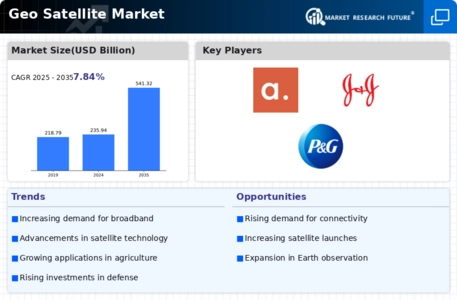Market Growth Projections
The Global Geo Satellite Market Industry is projected to experience robust growth over the next decade. With a market value of 235.94 USD Billion in 2024, it is anticipated to reach 541.32 USD Billion by 2035, reflecting a CAGR of 7.84% from 2025 to 2035. This growth trajectory is indicative of the increasing reliance on satellite technology across various sectors, including communication, earth observation, and defense. The expansion of applications and technological advancements are likely to drive this upward trend, positioning the geo satellite market as a critical component of the global economy.
Government Investments in Space Programs
Government investments in space programs significantly influence the Global Geo Satellite Market Industry. Many countries are allocating substantial budgets to enhance their satellite capabilities, recognizing the strategic importance of space technology for national security, communication, and scientific research. These investments often lead to the development of new satellite systems and infrastructure, fostering innovation and competition within the market. As nations strive to establish or maintain their presence in space, the demand for geo satellites is likely to increase, further propelling market growth. This trend underscores the critical role of government support in shaping the future of the satellite industry.
Expansion of Earth Observation Applications
The Global Geo Satellite Market Industry is witnessing a notable expansion in earth observation applications, which are crucial for environmental monitoring, agriculture, and disaster management. Governments and organizations utilize satellite imagery to track climate change, assess natural resources, and respond to emergencies. This trend is expected to contribute significantly to market growth, as the industry adapts to the increasing need for precise data. The integration of advanced sensors and imaging technologies enhances the capabilities of geo satellites, making them indispensable tools for various sectors. As a result, the market is anticipated to grow at a CAGR of 7.84% from 2025 to 2035.
Rising Applications in Defense and Security
The Global Geo Satellite Market Industry is increasingly driven by rising applications in defense and security sectors. Governments worldwide are leveraging satellite technology for surveillance, reconnaissance, and secure communications. The ability to gather real-time intelligence and monitor activities from space enhances national security measures. This growing reliance on geo satellites for defense purposes is expected to contribute to market expansion. As geopolitical tensions rise, investments in satellite systems are likely to increase, further solidifying the role of geo satellites in maintaining security. The defense sector's demand for advanced satellite capabilities is a key factor in the industry's growth trajectory.
Increasing Demand for Communication Services
The Global Geo Satellite Market Industry experiences a surge in demand for communication services, driven by the growing need for reliable connectivity across various sectors. As businesses and governments increasingly rely on satellite technology for communication, the market is projected to reach 235.94 USD Billion in 2024. This demand is particularly pronounced in remote areas where terrestrial infrastructure is lacking. The ability of geo satellites to provide high-speed internet and telecommunication services enhances operational efficiency and connectivity, thereby propelling market growth. Furthermore, advancements in satellite technology are likely to improve service quality, further stimulating demand.
Technological Advancements in Satellite Systems
Technological advancements play a pivotal role in shaping the Global Geo Satellite Market Industry. Innovations such as miniaturization of satellite components, improved propulsion systems, and enhanced data processing capabilities are transforming satellite design and functionality. These advancements not only reduce costs but also increase the efficiency and lifespan of satellites. As a result, more organizations are likely to invest in satellite technology, leading to a broader range of applications. The ongoing development of next-generation satellites is expected to drive market growth, with projections indicating a market value of 541.32 USD Billion by 2035.

















Leave a Comment